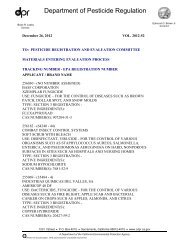Environmental Fate of Imidacloprid - California Department of ...
Environmental Fate of Imidacloprid - California Department of ...
Environmental Fate of Imidacloprid - California Department of ...
You also want an ePaper? Increase the reach of your titles
YUMPU automatically turns print PDFs into web optimized ePapers that Google loves.
If imidacloprid were to enter surface water, the photodegradation half-life in water is<br />
less than 3 hours. Without light, hydrolysis can range from 33 to 44 days. When<br />
applied according to label directions the potential for toxicity to fish is low with a LC50<br />
level <strong>of</strong> 211 ppm for the rainbow trout. No studies have been done to determine or<br />
identify imidacloprid in fish.<br />
Summary<br />
<strong>Imidacloprid</strong> is a systemic, chloronicotinoid insecticide, which kills insects via ingestion<br />
or contact. It is effective by disrupting the nervous system <strong>of</strong> an insect pest. It is used<br />
for controlling sucking insects, soil insects, termites, and some chewing insects. It is<br />
applied as a seed and soil treatment, crop and structural treatment, and a topical flea<br />
control treatment on domestic pets.<br />
The low vapor pressure <strong>of</strong> 1.0 x 10 -7 mm Hg indicates that this insecticide is nonvolatile.<br />
Also, the low Henry's law constant <strong>of</strong> 6.5 x 10 -11 atm m 3 / mole, indicates that it<br />
has low volatility from water. Therefore, it is unlikely to be dispersed in air over a large<br />
area from volatilization.<br />
Hydrolysis <strong>of</strong> imidacloprid can range from 33 to 44 days at pH 7 and 25 o C. The<br />
aqueous photolysis half-life is less than 3 hours. The soil surface photolysis <strong>of</strong><br />
imidacloprid has a half-life <strong>of</strong> 39 days, and in soil the half-life ranges from 26.5 to 229<br />
days. This persistence in soil allows continual availability for uptake by roots.<br />
The soil adsorption coefficient <strong>of</strong> 132 to 310, combined with a high water solubility <strong>of</strong><br />
5.14 x 10 2 ppm, suggests a potential to leach to ground water.<br />
The potential for toxicity to fish is low with a LC50 level <strong>of</strong> 211 ppm for the rainbow<br />
trout. Even with a potential to persist in soil, the potential for imidacloprid to<br />
bioaccumulate in the environment is low due to the high photodegradation tendency and<br />
high water solubility.
















